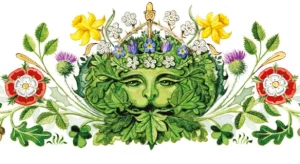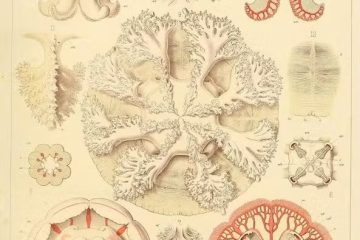King Charles: Pagan Green Man?
By Bron Taylor

On 4 April 2023, at its official website, the British Royal Family revealed the design of the invitation to the Coronation of King Charles. Hand-painted by heraldry artist Andrew Jamieson, the invitation incorporated wildflowers and wildlife, including a unicorn, and symbols representing the new King and Queen Consort.
It also featured an enigmatic image of a foliage-entangled human face, which has become known as the Green Man.
As explained on the Royal Family’s official website, “Central to the design is the motif of the Green Man, an ancient figure from British folklore, symbolic of spring and rebirth, to celebrate the new reign. The shape of the Green Man, crowned in natural foliage, is formed of leaves of oak, ivy and hawthorn, and the emblematic flowers of the United Kingdom.”
The image immediately drew curiosity and controversy. Some commentators (e.g., Cassandra Harrington and Diana Darke) sought to illuminate the historical origins of such iconography. Others, including Jonathan Jones, expressed alarm, viewing the image as a symbol of an idolatrous and shameful paganism.
To such alarmism Zac Goldsmith, an ardent environmentalist and prominent conservative Member of Parliament, and a former editor of The Ecologist, rejoindered. He reasoned that Green Man images have been sculpted into Christian Churches for a millennium and that they symbolized an appreciation for God’s creation. (Not incidentally, Zac Goldsmith is the son of the billionaire tycoon James Goldsmith and the nephew of Edward (Teddy) Goldsmith. Teddy Goldsmith founded The Ecologist, once the most widely read environmental journal in the world, which was translated in many languages. Despite his atheism, in 1993, with the publication of his magnum opus, The Way: An Ecological World-View, he promoted a radical environmental worldview and a naturalistic nature spirituality.)
Meanwhile, Steven Posch, a Pagan writer, asserted that, although Prince of Wales Charles indicated he wanted to be defender of faith not of the faith, he is obviously a Christian. Posch added that the King’s embrace of the Green Man reflects a sentiment that is common among Pagans, namely, kinship with nature. In King Charles, Posh concluded, Pagans had not only an ecumenical King but a “pro-pagan monarch.”
Although the Green Man invitation is an intriguing place to look for clues about King Charles’ worldview, better ones appear in his 2010 book, Harmony: A New Way of Looking at Our World. In it, he expressed an eclectic and deeply ecumenical nature spirituality. Indeed, he repeatedly (if inaccurately) claimed that all ancient traditions share a sense of the sacred in nature and an ethical obligation to treat it with reverence.
Writing then as the Prince of Wales, Charles was careful to express respect for the predominant Western religions (Judaism, Christianity, and Islam) even while criticizing the desacralizing forces that, he argued, have characterized much post-Enlightenment Western philosophy and science. And by regularly using the term ‘creation’ as a synonym for nature, Charles seemed to express a belief in a divine creator.
Far more often, however, in this book he sounded pantheistic and pagan.
He concluded, for example, that to achieve harmony with life on earth, we must strive for a “sense of the sacred in life; for reverence and even, dare I say it, for a touch of enlightened deference to Nature. After all, she is our ultimate ‘sustainer’” (p. 325).
Charles’ daring in this passage, especially considering that he was then slated to become King and the head of the Anglican Church, was in expressing a profoundly heterodox, if not subtly a pantheistic and pagan view, that Nature is God. The book is replete with further clues that seem to support such a conclusion.
Despite the presence of such evidence, however, before and after his ascension to the throne, King Charles has remained circumspect about his personal religious beliefs. Given his reticence, any effort to discern the precise nature of his religious views requires some speculation. This is the case whether one analyzes his writing or considers his embrace of the Green Man as a kind of alter ego. The King has managed to shroud his nature spirituality in mystery.
If this is a self-conscious strategy, it is brilliant.
Increasing proportions of the human community find spiritual meaning and purpose in nature. Others believe in a creator deity. Most societies around the world are increasingly diverse. The new monarch of the United Kingdom has, therefore, a tremendous challenge, uniting a people with exceptionally diverse religious beliefs. But all these people share at least one thing: an ultimate dependence on nature for their Earthly lives.
By promoting the idea that everyone, whatever worldviews they hold dear, should understand this world as sacred and worthy of reverent care, King Charles may not only contribute to uniting his own Kingdom, but to his envisioned harmony between humankind and the rest of the living world.
#
Bron Taylor, Professor of Religion and Nature, University of Florida; author of Dark Green Religion: Nature Spirituality and the Planetary Future (University of California Press, 2010), and the editor of the Encyclopedia of Religion and Nature (2005). He is also the founding editor of the Journal for the Study of Religion, Nature and Culture, and with University of Oslo cultural historian Karen Lykke, has just put into production a special issue of it titled Searching for the Green Man. It will be published later in 2023.
[email protected]; www.brontaylor.com; Twitter: @BronTaylor
Counterpoint blogs may be reprinted with the following acknowledgement: “This article was published by Counterpoint: Navigating Knowledge on 5 May 2023.” The views and opinions expressed on this website, in its publications, and in comments made in response to the site and publications are those of the author(s) and do not necessarily reflect the views and opinions of Counterpoint: Navigating Knowledge, its founders, its staff, or any agent or institution affiliated with it, nor those of the institution(s) with which the author is affiliated. Counterpoint exists to promote vigorous debate within and across knowledge systems and therefore publishes a wide variety of views and opinions in the interests of open conversation and dialogue.
Photo credit: Invitation to the Coronation of King Charles (detail). Hand-painted by heraldry artist Andrew Jamieson. Downloaded from the Royal Family’s official website.



